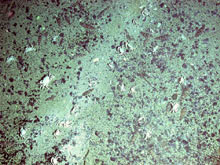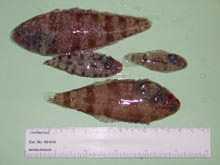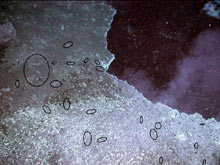One fish seems to thrive around the hydrothermal vents of the Mariana volcanoes. At Daikoku and Nikko volcanoes tonguefish and crabs cover the sea floor in some areas. Click image for larger view and image credit.
These four tonguefish samples are from Nikko volcano. The fish at Nikko are almost twice as big as their counterparts on Daikoku. The largest sample here is less than 11 cm (5 in) long. Click image for larger view and image credit.
So, Where Are All the Fish?
May 11, 2006
John Dower
Biological Oceanographer
University of Victoria
![]() Discover a dense group of tonguefish on the sedimented sea floor at Daikoku. (Quicktime, 1.7 Mb.)
Discover a dense group of tonguefish on the sedimented sea floor at Daikoku. (Quicktime, 1.7 Mb.)
![]() A dead mid-water fish floated down to the sea floor and is attacked by tonguefish at Daikoku. (Quicktime, 1.8 Mb.)
A dead mid-water fish floated down to the sea floor and is attacked by tonguefish at Daikoku. (Quicktime, 1.8 Mb.)
If you have been viewing our photos and videos you may have wondered about the lack of brightly colored fish often associated with tropical marine ecosystems. The fact is, although vent ecosystems support a wide range of invertebrates (such as crabs, shrimp, mussel, worms, etc.), they very often lack resident fish species. Although the reason for this is unclear, it may indicate that fish are unable to withstand the harsh chemical environments associated with hydrothermal vents. Where fish have been observed at vents, they tend to make short feeding forays into the vent area before retreating to the surrounding non-vent waters.
Remarkably, there is at least one fish species that not only survives but actually seems to thrive around the hydrothermal vents of the Mariana volcanoes. First observed on our 2004 Submarine Ring of Fire cruise, the fish has since been determined to be a new species of tonguefish (a type of flatfish) in the genus Symphurus. Very dense populations of this little fish occur at both Daikoku and Nikko. During this trip, we managed to use the remotely operated vehicle Jason's suction sampler to slurp samples of these fish off the bottom.
We have yet to determine how these tonguefish are making a living. They must be doing something right, however, because in some areas they literally cover the bottom (including right at the edge of the molten sulfur wells on both Daikoku and Nikko)! Since they usually occur on sedimented slopes, and appear to ingest the sulfurous sediments, we suspect that they may be digesting small worms from the sediments. On Nikko, however, these tonguefish also occur on the unsedimented bottom of the fossil sulfur lake, leading us to speculate that they may also be capable of feeding directly on hydrothermal bacteria, another first for a vent fish species.
One final puzzle is that the tonguefish at Nikko are almost twice as big as their counterparts on Daikoku. There are at least two possible explanations for this. First, it may be that Nikko is a more productive environment than Daikoku, thereby enabling the Nikko tonguefish to grow larger. Alternatively, the smaller tonguefish on Daikoku may simply be younger than the Nikko fish. If so, it would suggest that the Daikoku population represents a recent colonization event. We hope to sort out this story over the coming months by extracting the ear-bones (known as otoliths) from the tonguefish specimens collected on Nikko and Daikoku. These ear-bones contain a series of daily and annual rings that can be used to age individual fish in the same way that tree-rings can be used to estimate the age and growth rates of trees.
Sign up for the Ocean Explorer E-mail Update List.































